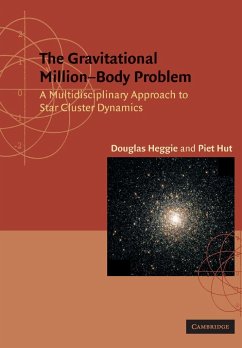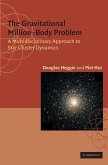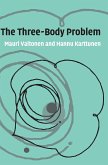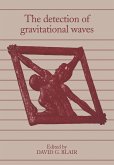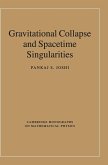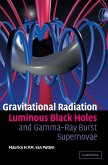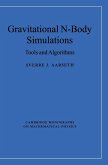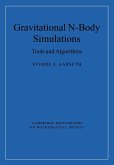- Broschiertes Buch
- Merkliste
- Auf die Merkliste
- Bewerten Bewerten
- Teilen
- Produkt teilen
- Produkterinnerung
- Produkterinnerung
A 2003 graduate text describing the theory astronomers need for studying globular star clusters.
Andere Kunden interessierten sich auch für
![The Gravitational Million Body Problem The Gravitational Million Body Problem]() Douglas HeggieThe Gravitational Million Body Problem254,99 €
Douglas HeggieThe Gravitational Million Body Problem254,99 €![The Three-Body Problem The Three-Body Problem]() Mauri ValtonenThe Three-Body Problem111,99 €
Mauri ValtonenThe Three-Body Problem111,99 €![The Detection of Gravitational Waves The Detection of Gravitational Waves]() David G. Blair (ed.)The Detection of Gravitational Waves64,99 €
David G. Blair (ed.)The Detection of Gravitational Waves64,99 €![Gravitational Collapse and Spacetime Singularities Gravitational Collapse and Spacetime Singularities]() Pankaj S. JoshiGravitational Collapse and Spacetime Singularities154,99 €
Pankaj S. JoshiGravitational Collapse and Spacetime Singularities154,99 €![Gravitational Radiation, Luminous Black Holes and Gamma-Ray Burst Supernovae Gravitational Radiation, Luminous Black Holes and Gamma-Ray Burst Supernovae]() Maurice H. P. M. van PuttenGravitational Radiation, Luminous Black Holes and Gamma-Ray Burst Supernovae144,99 €
Maurice H. P. M. van PuttenGravitational Radiation, Luminous Black Holes and Gamma-Ray Burst Supernovae144,99 €![Gravitational N-Body Simulations Gravitational N-Body Simulations]() Sverre J. AarsethGravitational N-Body Simulations226,99 €
Sverre J. AarsethGravitational N-Body Simulations226,99 €![Gravitational N-Body Simulations Gravitational N-Body Simulations]() Sverre J. AarsethGravitational N-Body Simulations84,99 €
Sverre J. AarsethGravitational N-Body Simulations84,99 €-
-
-
A 2003 graduate text describing the theory astronomers need for studying globular star clusters.
Hinweis: Dieser Artikel kann nur an eine deutsche Lieferadresse ausgeliefert werden.
Hinweis: Dieser Artikel kann nur an eine deutsche Lieferadresse ausgeliefert werden.
Produktdetails
- Produktdetails
- Verlag: Cambridge University Press
- Seitenzahl: 372
- Erscheinungstermin: 23. Januar 2003
- Englisch
- Abmessung: 244mm x 170mm x 20mm
- Gewicht: 641g
- ISBN-13: 9780521774864
- ISBN-10: 0521774861
- Artikelnr.: 21845355
- Herstellerkennzeichnung
- Libri GmbH
- Europaallee 1
- 36244 Bad Hersfeld
- gpsr@libri.de
- Verlag: Cambridge University Press
- Seitenzahl: 372
- Erscheinungstermin: 23. Januar 2003
- Englisch
- Abmessung: 244mm x 170mm x 20mm
- Gewicht: 641g
- ISBN-13: 9780521774864
- ISBN-10: 0521774861
- Artikelnr.: 21845355
- Herstellerkennzeichnung
- Libri GmbH
- Europaallee 1
- 36244 Bad Hersfeld
- gpsr@libri.de
Douglas Heggie is Professor of Mathematical Astronomy at the University of Edinburgh, Scotland.
Part I. Introductions: 1. Astrophysics introduction
2. Theoretical physics introduction
3. Computational physics introduction
4. Mathematical introduction
Part II. The Continuum Limit: 5. Paradoxical thermodynamics
6. Statistical mechanics
7. Motion in a central potential
8. Some famous models
9. Methods
Part III. Mean Field Dynamics: 10. Violent relaxation
11. Internal mass loss
12. External influences
Part IV. Microphysics: 13. Exponential orbit instability
14. Two-body relaxation
15. From Kepler to Kustaanheimo
Part V. Gravothermodynamics: 16. Escape and mass segregation
17. Gravothermal instability
18. Core collapse rate for star clusters
Part VI. Gravitational Scattering: 19. Thought experiments
20. Mathematical three-body scattering
21. Analytical approximations
22. Laboratory experiments
23. Gravitational burning and transmutation
Part VII. Primordial Binaries: 24. Binaries in star clusters
25. Triple formation and evolution
26. A non-renewable energy source
Part VIII. Post-Collapse Evolution: 27. Surviving core collapse
28. Gravothermal oscillations
29. Dissolution
Part IX. Star Cluster Ecology: 30. Stellar and dynamical evolution
31. Collisions and capture
32. Binary star evolution and blue stragglers
33. Star cluster evolution
Appendices.
2. Theoretical physics introduction
3. Computational physics introduction
4. Mathematical introduction
Part II. The Continuum Limit: 5. Paradoxical thermodynamics
6. Statistical mechanics
7. Motion in a central potential
8. Some famous models
9. Methods
Part III. Mean Field Dynamics: 10. Violent relaxation
11. Internal mass loss
12. External influences
Part IV. Microphysics: 13. Exponential orbit instability
14. Two-body relaxation
15. From Kepler to Kustaanheimo
Part V. Gravothermodynamics: 16. Escape and mass segregation
17. Gravothermal instability
18. Core collapse rate for star clusters
Part VI. Gravitational Scattering: 19. Thought experiments
20. Mathematical three-body scattering
21. Analytical approximations
22. Laboratory experiments
23. Gravitational burning and transmutation
Part VII. Primordial Binaries: 24. Binaries in star clusters
25. Triple formation and evolution
26. A non-renewable energy source
Part VIII. Post-Collapse Evolution: 27. Surviving core collapse
28. Gravothermal oscillations
29. Dissolution
Part IX. Star Cluster Ecology: 30. Stellar and dynamical evolution
31. Collisions and capture
32. Binary star evolution and blue stragglers
33. Star cluster evolution
Appendices.
Part I. Introductions: 1. Astrophysics introduction
2. Theoretical physics introduction
3. Computational physics introduction
4. Mathematical introduction
Part II. The Continuum Limit: 5. Paradoxical thermodynamics
6. Statistical mechanics
7. Motion in a central potential
8. Some famous models
9. Methods
Part III. Mean Field Dynamics: 10. Violent relaxation
11. Internal mass loss
12. External influences
Part IV. Microphysics: 13. Exponential orbit instability
14. Two-body relaxation
15. From Kepler to Kustaanheimo
Part V. Gravothermodynamics: 16. Escape and mass segregation
17. Gravothermal instability
18. Core collapse rate for star clusters
Part VI. Gravitational Scattering: 19. Thought experiments
20. Mathematical three-body scattering
21. Analytical approximations
22. Laboratory experiments
23. Gravitational burning and transmutation
Part VII. Primordial Binaries: 24. Binaries in star clusters
25. Triple formation and evolution
26. A non-renewable energy source
Part VIII. Post-Collapse Evolution: 27. Surviving core collapse
28. Gravothermal oscillations
29. Dissolution
Part IX. Star Cluster Ecology: 30. Stellar and dynamical evolution
31. Collisions and capture
32. Binary star evolution and blue stragglers
33. Star cluster evolution
Appendices.
2. Theoretical physics introduction
3. Computational physics introduction
4. Mathematical introduction
Part II. The Continuum Limit: 5. Paradoxical thermodynamics
6. Statistical mechanics
7. Motion in a central potential
8. Some famous models
9. Methods
Part III. Mean Field Dynamics: 10. Violent relaxation
11. Internal mass loss
12. External influences
Part IV. Microphysics: 13. Exponential orbit instability
14. Two-body relaxation
15. From Kepler to Kustaanheimo
Part V. Gravothermodynamics: 16. Escape and mass segregation
17. Gravothermal instability
18. Core collapse rate for star clusters
Part VI. Gravitational Scattering: 19. Thought experiments
20. Mathematical three-body scattering
21. Analytical approximations
22. Laboratory experiments
23. Gravitational burning and transmutation
Part VII. Primordial Binaries: 24. Binaries in star clusters
25. Triple formation and evolution
26. A non-renewable energy source
Part VIII. Post-Collapse Evolution: 27. Surviving core collapse
28. Gravothermal oscillations
29. Dissolution
Part IX. Star Cluster Ecology: 30. Stellar and dynamical evolution
31. Collisions and capture
32. Binary star evolution and blue stragglers
33. Star cluster evolution
Appendices.

